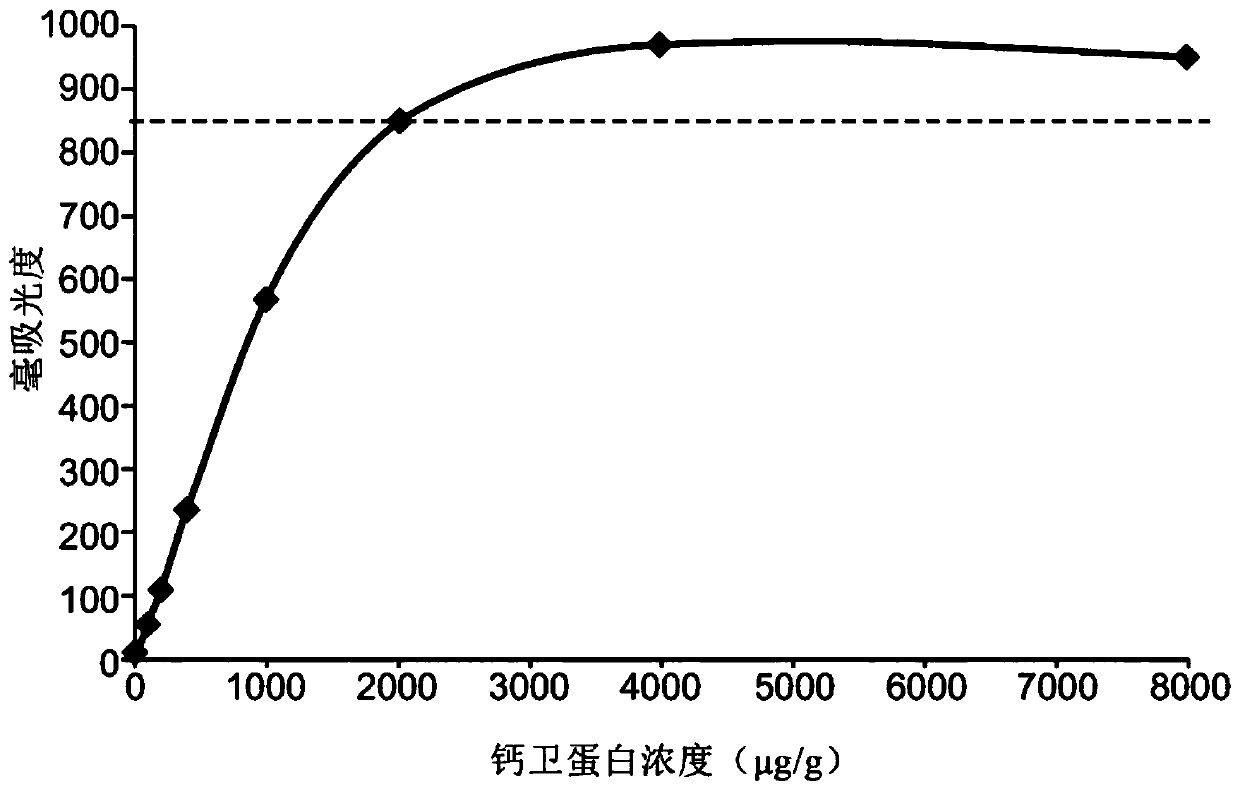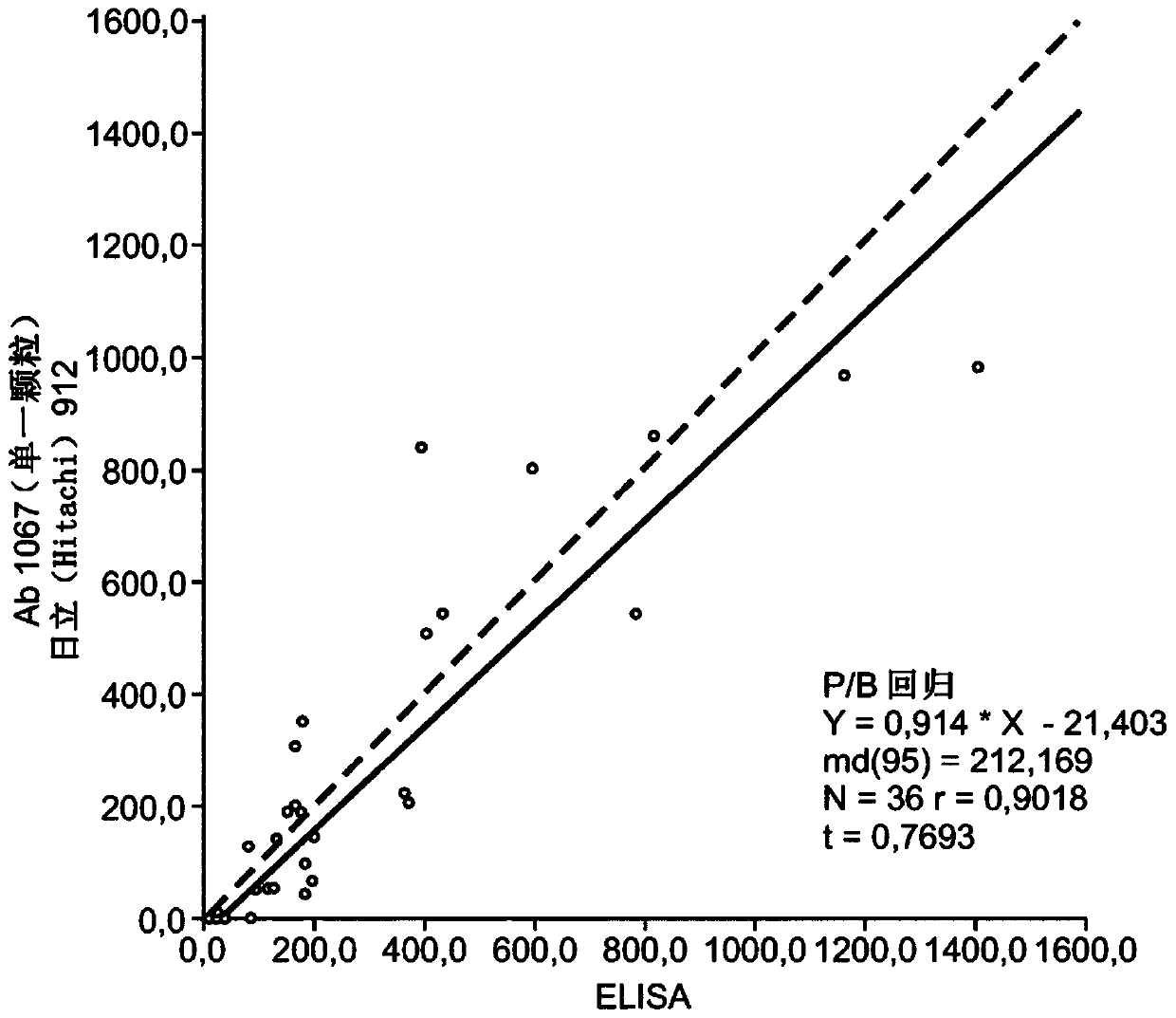Method for determination of members of the S100 family of calcium binding proteins by immunoturbidimetry
A technology of immunoturbidimetry and calprotectin, applied in the field of turbidimetry and detection system
- Summary
- Abstract
- Description
- Claims
- Application Information
AI Technical Summary
Problems solved by technology
Method used
Image
Examples
Embodiment 1
[0097] Example 1 Preparation of anti-calprotectin immune particles
[0098] Latex particles from well-known manufacturers such as MERCK, Bangs Laboratories were used. The latex is carboxylated polystyrene or chloromethyl latex. The latex particles had the following parameters: surface charge density 62 μC / cm2; surface charge density 163 μEq / g pol; solids content 9.0%; stabilized with 0.05% sodium azide. Immune particles were prepared by covalently linking purified murine monoclonal antibodies (mAB 1062, 1067, 1069, 1089, and incorporated in the first reaction component) against purification from granulocytes with intact lysosomal membranes Human Calprotectin. The size of the carboxylated polystyrene particles is preferably uniform (175 nm). Alternatively, nanoparticles of two different sizes (160-175nm and 250-275nm) were coated with a single monoclonal antibody (see Image 6 ). Latex particles of a single size of 175 nm can also be coated with two different monoclonal ...
Embodiment 2
[0100] Example 2 Extraction of stool samples
[0101] The fecal sample extraction method is as follows. 15 mg of feces were diluted 1:100 in 1.5 ml of buffer. Fill empty sample tubes with 1.5 ml assay buffer, 50 mM maleate (pH 5.0), 150 mM NaCl, sodium azide, 0.1% sodium dodecyl sulfate, bovine serum albumin, with or without IgM antiserum was added. For comparison, the ready-to-use IDK was also used at room temperature Extraction buffer (Cat. No. K 6967) and Bühlmann fCal Turbotm extraction buffer were used to extract samples. Fecal samples were collected and stored at 2-8°C for 48h. Long-term (up to 12 months) storage at -20°C is recommended. At the beginning of the turbidimetric test, thaw the frozen sample slowly, preferably at 2-8°C. In some cases, inhomogeneous samples were mechanically homogenized. For sample collection, use Fecal Sample Application System (SAS) (Cat. No. K6998SAS). The tip of the SAS test strip has a notch to hold a certain amount of raw ma...
Embodiment 3
[0102] Example 3 Calprotectin immunoturbidimetric analysis
[0103] Samples extracted with any of the above extraction buffers were used for turbidimetric assays using an apparatus Roche Hitachi 912 according to the manufacturer's instructions. 10 μl of extraction samples were added to 200 μl of assay buffer and 50 μl of storage buffer with sodium citrate (pH 5.0), bovine serum albumin, Tween 20, sucrose, sodium azide. The automated analyzer gently mixes the immunoparticles with the extracted sample while incubating at 37°C for 5 minutes. While gently shaking, add the second reaction component containing the particles bearing the immobilized monoclonal antibody. At 37°C, the agglutination time was 5 minutes, during which time the absorbance was measured. Repeat the measurement. Absorbance values were obtained by reading at a wavelength of 570 nm.
[0104] Commercially purified calprotectin was diluted in pH=5.4 citrate buffer, ranging from 0 to 2000 μg / g. (6 calibrati...
PUM
| Property | Measurement | Unit |
|---|---|---|
| diameter | aaaaa | aaaaa |
| molecular weight | aaaaa | aaaaa |
| diameter | aaaaa | aaaaa |
Abstract
Description
Claims
Application Information
 Login to View More
Login to View More - R&D
- Intellectual Property
- Life Sciences
- Materials
- Tech Scout
- Unparalleled Data Quality
- Higher Quality Content
- 60% Fewer Hallucinations
Browse by: Latest US Patents, China's latest patents, Technical Efficacy Thesaurus, Application Domain, Technology Topic, Popular Technical Reports.
© 2025 PatSnap. All rights reserved.Legal|Privacy policy|Modern Slavery Act Transparency Statement|Sitemap|About US| Contact US: help@patsnap.com



